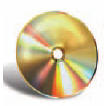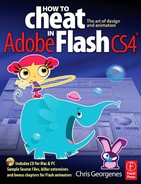EASING IS ALWAYS the icing on the cake for me when I am producing animations. It’s usually the final step in my process. Once all key poses are created and Motion tweens applied, the final step is applying easing for that extra touch of realism. Easing is usually applied in 2 ways: easing in and easing out. Easing in calculates the rate of each frame so that the animation starts slow and gradually increases speed. Easing out is the opposite where the rate of speed is reduced as the animation plays. A perfect example of easing is when a ball is thrown towards the sky. Gravity’s constant force gradually slows the ball down until it changes direction, returning to Earth with a gradual increase in speed. With easing, you can adjust the rate of change to the values for more natural or more complex animation.

1 Using an image of a crane is about as basic as it gets. The armature consists of only 2 bones since all we need to move is the cable with the ball attached. The animation requires that the ball travels back and forth much like a pendulum. To imply gravity we need to apply an ease in and an ease out for each direction the ball moves. Position the ball to the far right or far left in the first keyframe. Move the playhead to the middle of the span and position the ball in the opposite direction. ![]()
![]() + click the first keyframe, right-click and select Copy Pose.
+ click the first keyframe, right-click and select Copy Pose. ![]()
![]() + click the last frame and right-click and select Paste Pose. You now have a swinging ball on a crane that loops back and forth seamlessly.
+ click the last frame and right-click and select Paste Pose. You now have a swinging ball on a crane that loops back and forth seamlessly.
To add the easing, select any frame between the first 2 keyframes. In the Properties panel use the Ease drop-down menu to select Slow and Stop (Slow). Adjust the easing strength to -100 using the hot text slider. You can also click on this value to select it and type in “-100”. Repeat this same procedure for the 2nd half of the armature span.

2 Here’s a slightly more complex Bone armature involving a cartoon figure with a head and 4 limbs. I used an extra symbol that was not a part of the character’s design for the root bone to be attached to. You can see this root bone start between the character’s feet. The concept here was to assign the root bone to an object not integrated into the character’s design. This allows for all of the character’s symbols to be assigned non-root bones, allowing more articulation. Once all the key poses have been created, all that is left to do is to add some easing from pose to pose. This helps create a more natural movement for the character. Just like with the crane example, select any frame between the keyframes and in the Properties panel use the Ease drop-down menu to select a preset ease. Adjust the easing strength to -100 or 100 depending on your needs. If you want the preset to ease in, then use a negative value. A positive value will apply easing out to the animation. The value refers to the strength of the ease.


Hot Tip
The Motion Editor does not support Armature spans. Therefore, you can not apply custom easing to armatures. The only easing for armatures is the presets available in the Properties panel. Having the ability to create custom eases and possibly edit the property curves of an armature span may be a valid feature request for a future version of Flash.
![]()
